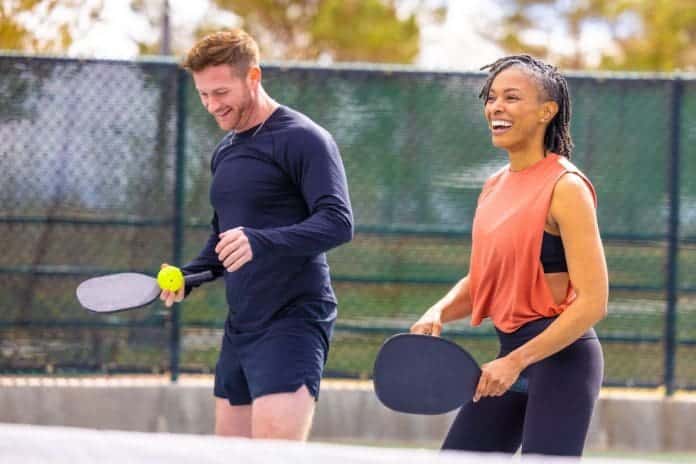Pickleball Workout Vs Other Racquet Sports: In the ongoing debate over the workout benefits of pickleball compared to other racquet sports, recent data provides fresh insights. A comprehensive study was conducted to evaluate how pickleball stacks up against tennis, squash, and racquetball in terms of exercise intensity. The researcher, armed with an Apple Watch, collected data across various competitive settings and sports, focusing on active calories burned, total calories burned, and heart rate metrics.
When we talk about Pickleball Workout Vs Other Racquet Sports, this analysis revealed that pickleball singles emerged as the most intense workout among the racquet sports studied, significantly outpacing the others in terms of exercise intensity. In contrast, pickleball open play doubles was notably less demanding. Competitive tennis ranked higher than squash and racquetball in calorie expenditure, although it is possible that more skilled players in these sports might burn more calories per hour than observed.
Key Findings
Pickleball Singles (Tournament)
- Active Calories/Hour: 451
- Total Calories/Hour: 578
- Average Heart BPM: 116
- Average Vigor: 9/10
Overview: Pickleball singles emerged as the most intense workout among the sports studied. With high heart rates and substantial calorie expenditure, it’s clear why tournament singles are so demanding. The highest reading was from a 20-minute tournament game, showing an average of 515 active calories per hour.
Tennis Singles (Competitive)
- Active Calories/Hour: 437
- Total Calories/Hour: 563
- Average Heart BPM: 115
- Average Vigor: 9/10
Overview: Tennis singles followed closely, highlighting the rigorous nature of the sport. The combination of serving and rallying contributes to its demanding workout profile, making it a formidable competitor in this lineup.
Tennis Doubles (Competitive)
- Active Calories/Hour: 405
- Total Calories/Hour: 530
- Average Heart BPM: 105
- Average Vigor: 6/10
Overview: Tennis doubles yielded surprising results, showing less calorie burn than singles due to the more sedentary nature of the sport. The level of play and frequent standing around contributed to this outcome.
Squash Singles (Competitive)
- Active Calories/Hour: 402
- Total Calories/Hour: 523
- Average Heart BPM: 103
- Average Vigor: 8/10
Overview: Squash singles, though intensely fast-paced, showed lower calorie burn than expected. This discrepancy might be attributed to the intermittent rest periods between intense bursts of activity.
Pickleball Doubles (Competitive/Tournament)
- Active Calories/Hour: 401
- Total Calories/Hour: 523
- Average Heart BPM: 112
- Average Vigor: 8/10
Overview: Competitive pickleball doubles was notably less intense than singles. The reduced movement and dependency on a partner’s activity level contribute to this lower calorie burn.
Racquetball Singles (Competitive/Tournament)
- Active Calories/Hour: 399
- Total Calories/Hour: 524
- Average Heart BPM: 99
- Average Vigor: 9/10
Overview: Despite racquetball’s reputation for high calorie burn, the study’s results were modest. The overall calorie expenditure was lower than expected, potentially due to variations in individual play and game structure.
Pickleball Doubles (Open Play)
- Active Calories/Hour: 370
- Total Calories/Hour: 496
- Average Heart BPM: 101
- Average Vigor: 5/10
Overview: Open play doubles in pickleball workout showed the lowest intensity, with significant time spent waiting between games. This lower activity level shows the criticism that casual play can lack the rigorous exercise of more competitive settings.
To maximize workout and health benefits in pickleball, players should opt for singles or engage in competitive settings with similarly skilled opponents. Casual or open play, particularly with lower-skilled participants, often results in lower exercise intensity. Higher-level play in any sport generally correlates with increased caloric expenditure, showing the importance of skill and competition in achieving a robust workout.

News in Brief: Pickleball Workout Vs Other Racquet Sports
Recent data comparing pickleball to tennis, squash, and racquetball reveals that pickleball singles offers the most intense workout among these sports, with the highest active and total calorie burn. Competitive tennis also ranks highly, surpassing squash and racquetball in calorie expenditure.
Conversely, pickleball open play doubles is the least intense, with significantly lower calorie burn due to frequent downtime and lower activity levels. Tennis doubles, squash singles, and racquetball singles fall in between, with varying levels of exertion. To maximize workout benefits, players should focus on singles or competitive play rather than casual or open play.
ALSO READ: Morgan Evans On Offense to Defense Transition in Pickleball

